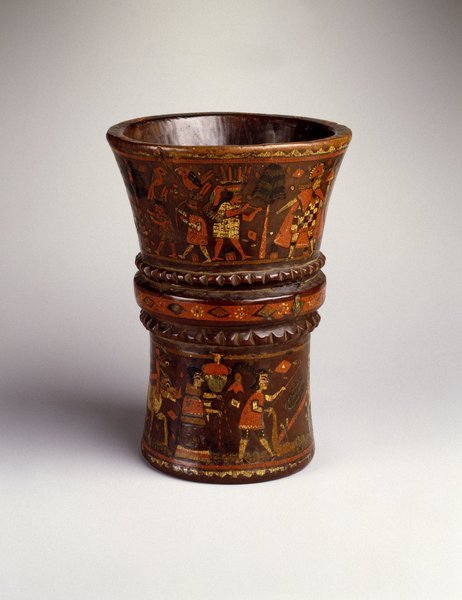Kero Cup Item Number: 42.149 from the Brooklyn Museum

Description
Kero cup with two registers of figural scenes separated by relief bands of flowers and geometric motifs. In the top register, two Incas battle three face-painted Antis or Chunchos. They wear spotted jaguar skin tunics and headdresses with two feathers in each. One of them has already fallen and lies under a tree, while the other two hold bows and arrows. A third Inca, wearing a checkerboard tunic, leads a fourth Anti, who wears a more elaborate feather headdress than the others and is presumably their leader, toward a castle and a seated Inca, possibly the Emperor himself. A hunchbacked figure holds a parasol over him. Above and to the right, a bird holds a sling and a bag in its beak. The lower register is an agricultural scene, possibly a ceremony, with two men guiding plows that are drawn by teams of two oxen. Each man is followed by a woman: one planting seeds and the other holding a pair of kero cups. During the Colonial era, Inca themes were generally portrayed on kero cups.
Credit Line
A. Augustus Healy Fund
Label
The original elite Inca owner of this kero cup employed the European tradition of figural representation to help legitimize his high rank in a visual language easily recognizable to the crown. The cup includes full-length depictions of soldiers or warriors, both Inca and facepainted Chuncho (an Amazonian group regarded by the Inca in the period as savage), in a battle scene from the past. An agricultural scene with oxen and oxen-drawn plows, both introduced by the Spanish, is included below. The decoration is carried out in the highly prized colonial lacquerwork technique of barniz de Pasto.
El dueño original de este kero, un inca de la élite, utilizó la tradición europea de representación figurativa para ayudar a legitimar su alto rango con un lenguaje visual fácilmente reconocible para la corona. El vaso incluye representaciones de soldados o guerreros de cuerpo entero, tanto incas como chunchos de cara pintada (grupo amazónico considerado salvaje por los incas del periodo), en una escena bélica del pasado. Una escena agrícola con bueyes y arados arrastrados por bueyes, ambos introducidos por los españoles, se incluye debajo. La decoración se ha ejecutado con la altamente valorada técnica de lacado colonial de barniz de Pasto.
Item History
- Made between 1675 and 1800
What
- Name
- Kero Cup
- Identification Number
- 42.149
- Type of Item
- kero and cup
- Material
- wood with pigment inlay
- Overall
- length 7.875 in, width 6.125 in, height 6.125 in
Who
- Culture
- Quechua
Where
- Holding Institution
- Brooklyn Museum
When
- Creation Date
- between 1675 and 1800
Other
- Location
- Luce Visible Storage and Study Center, 5th Floor
- Classification
- Vessel